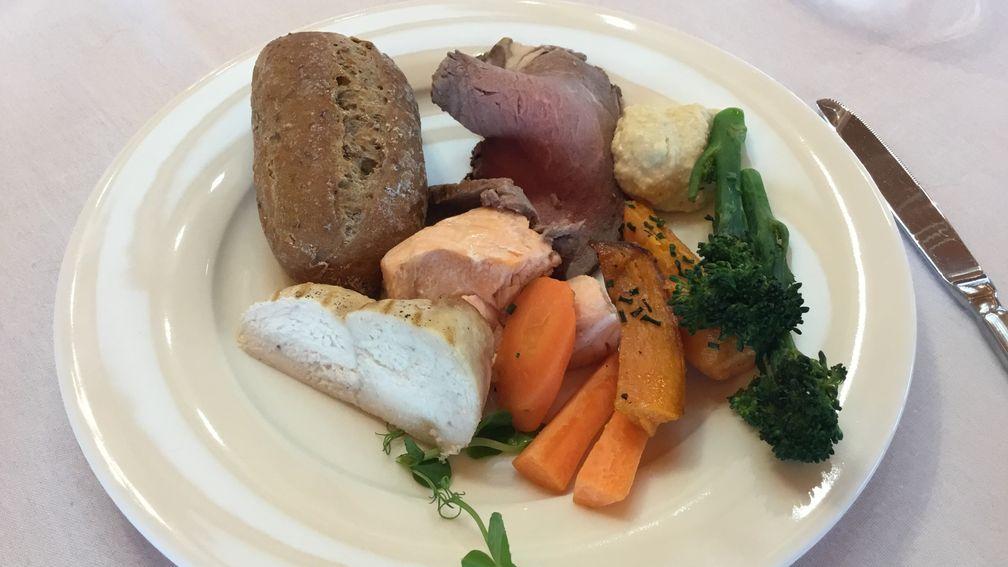Cooking up a healthy lifestyle for Britain's jockeys at York

David Carr heads to the Knavesmire to get the lowdown on the drive to improve jockeys' nutrition and diet...
Don't drink your calories – that's not a slogan you ever expect to hear at York racecourse.
This is the home of the John Smith's Cup, the place where a couple of oceans of ale and Prosecco are thrown down 30,000 mouths on a summer Saturday.
And there's plenty more lubrication here in the winter, when countless turkey dinners are enjoyed in the boozy build-up to Christmas.
Turkey is on the agenda again today but it's alongside high protein yoghurt and low fat mozzarella balls in a planned revamp of the most important menu of all.
For the racecourse catering that really makes a difference is the provision for the jockeys, the stars of the show, the athletes.
Or is that the word? Apparently half the people in the industry do not see jockeys as athletes, including plenty of riders themselves.
That's one of the many surprising findings that Dan Martin, a performance nutritionist with the Professional Jockeys Association and Injured Jockeys Fund delivers in the Parade Ring restaurant.
He has spent 18 months at Liverpool John Moores University looking into the perceptions and practices of jockeys' nutrition and weight-management – and the BHA-funded research produced worrying results.
Jockeys need to manage their weight even more than boxers or mixed martial artists as they ride every day. Yet, in an era when you can watch a race on a mobile phone, the most common methods are still reminiscent of the 18th century – starvation and dehydration.
The consequent calcium loss has a horrifying effect and 85 per cent of jockeys tested were found to have negative bone health –teenagers can have the bones of a middle-aged, sedentary man.
"It seems insane that jockeys should race at 35mph, jumping hurdles and fences with weak bones," says Martin.

Tests at John Moores also found that sweating to lose just two per cent of body weight reduces a jockey's upper body strength by 14 per cent and harms reaction time and decision-making.
There is another way
"But you don't have to do it that way," stresses Martin, addressing an invited audience of racecourse officials and caterers – who have a key role to play.
Adopting a high protein, low-carbohydrate diet reduces weight safely, cutting body fat – of which the study found that jockeys may have 5lb or 6lb too much. That's what Martin, PJA nutrition team leader Julia Scott-Douglas and others are working towards.
However the best of intentions are no use if the weighing-room canteen resembles a greasy spoon. And the riders involved in Martin's research did not hold back in their opinions of what they were sometimes offered on course – "you wouldn't feed some of that s*** to your dog," was one response.
Which is why Martin is here. This is part of an ongoing consultation process with courses, introducing them to the sort of catering that should be expected, high on protein like turkey, salmon or beef, with carbohydrates from sweet potato wedges or rice cakes.
Coffee, tea and sugar-free pop are among the alternative to drinking those calories, with gum a much healthier source of a caffeine kick than cans of Red Bull.
Presentation is also key, as anyone who remembers the gruesome-looking photographs of unappealing offerings that Cathy Gannon shared on social media the other year.
The idea is not to ban unhealthy food outright but, rather to offer a number of more desirable options and to put them on the left – that helps sell them, as research apparently shows that's the first place people look.
Advisory guidelines
Whatever the location, the samples certainly go down well when they are served to the guests, among whom PJA executive director Dale Gibson, who rode on the Flat for 24 years himself, particularly welcomes the initiative.
"We are trying to do away with bad practices," he says. "Bad food costs just as much as good food. The four or five racecourses lurking at the bottom of the list need to take the guidelines on board."
Those guidelines will be advisory when they are introduced in April, with a view to becoming a mandatory BHA general instruction 12 months later.
"I think in 2020 jockeys will look back on this and it will seem like when they banned smoking in the weighing room and introduced safety vests," says Martin.
"They will say, 'I can't believe they used to serve us fried food and chips'. That's my view anyway."

Published on 10 February 2018inNews
Last updated 16:20, 10 February 2018
- Merci Olivier! No final winner for Olivier Peslier but the world of racing unites in saluting the end of a great career
- The latest edition of the Racing Post is available to read online now - here's how you can access it
- How Smart View recorded a 76 per cent profit at the Cheltenham Festival
- Smart View is available on the Racing Post app - how to read the revolutionary new racecard
- Levy reform talks 'accelerating' as clock ticks down to April deadline for agreement
- Merci Olivier! No final winner for Olivier Peslier but the world of racing unites in saluting the end of a great career
- The latest edition of the Racing Post is available to read online now - here's how you can access it
- How Smart View recorded a 76 per cent profit at the Cheltenham Festival
- Smart View is available on the Racing Post app - how to read the revolutionary new racecard
- Levy reform talks 'accelerating' as clock ticks down to April deadline for agreement